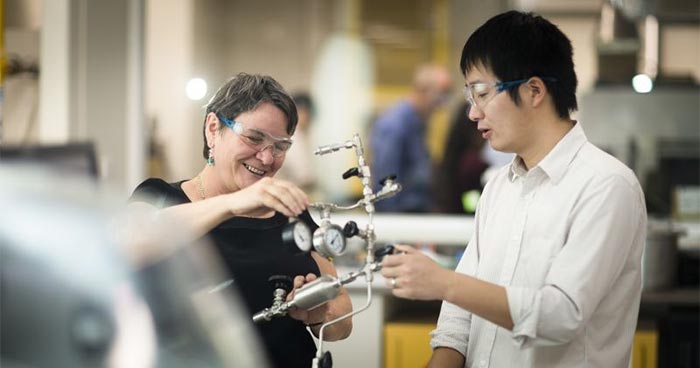Chemical engineering needs a reset
From food and energy to healthcare and the environment, chemical engineering is a multifaceted discipline that impacts the world in many ways.
You could make a case that engineering is generally not well-understood by the public compared with other professions.

The reality versus public perception of chemical engineering – a discipline with enormous impact on society – is particularly pronounced, according to Professor Sandra Kentish, Head of the School of Chemical and Biomedical Engineering at the University of Melbourne.
“A good 50 per cent of the country does not know what an engineer does,” Kentish said.
“I would estimate that only 10 per cent of the community knows what a chemical engineer does.
“Chemical engineering gives the impression of being a dirty industry, associated with the oil and gas industry, and that is essentially from where it developed. There’s a need to explain to young people that chemical engineering is not about destroying the planet, and it’s not about feeding the fossil fuel industry. It is very much about ensuring safe and sustainable outcomes for society.”
The chemistry industry is a quiet achiever, responsible for making sure enough food is grown and preserved, to ensuring the environment we live in is clean. We take for granted many of the applications of chemical engineering roles in everyday situations. According to Chemistry Australia, the sector’s “supply chain centrality” features as a supplier to 104 of the 108 sectors in the economy.
And the chemical engineers that make all this possible are disproportionately represented in management, said Kentish.
“The number of CEOs with chemical engineering backgrounds is very high,” she added.
Kentish’s work includes being part of an effort to reinvigorate the curriculum at the University of Melbourne. Preliminary data confirms some of the misconceptions mentioned above.
There’s a need to explain to young people that chemical engineering is not about destroying the planet, and it's not about feeding the fossil fuel industry
There are good reasons for a reset.
The number of enrolments for women in chemical engineering at the University of Melbourne is near 30 per cent, after being near parity early this century.
Among explanations for the dip are a shortage of girls taking the prerequisite subjects in high school, as well as competition from biomedical (near 50 per cent female) and environmental engineering.
Cutting carbon and salt to help the environment
The Head of School recognises her career focus on membrane technologies applied to energy, food and water, for its positive environmental impact.
This started with gas separation, which remains an interest, and nowadays also involves liquid applications. This research is part of the University’s interdisciplinary Food and Agribusiness research group.
"Seawater desalination and cleaning up wastewater are areas that are key to sustainability and environmental protection, and it gives you a sense of purpose," Kentish explained
In recent years, a lot of this work has been in the dairy industry, to reduce the amount of salty wastewater from processing. Wastewater goes into trade waste systems, creating issues with dryland salinity, whilst cheese whey sprayed on fields in the past has disrupted the underlying mineral balance.
Recent work has branched out into recovering the gas used by anaesthetists in hospitals. Anaesthetic gases such as sevoflurane are hundreds of times more potent than carbon dioxide as a greenhouse gas.
“The patient consumes about 4 per cent, the rest of that gas goes out through the hospital exhaust system and into the atmosphere,” Kentish said.
“So, we’ve been looking at ways of recycling the anaesthetic gas to reduce the environmental impact.”
Innovating with algae
Microalgae has also been fertile ground for sustainability-oriented projects.
In 2017, Kentish was named one of Australia’s Most Innovative Engineers for work using microalgae to sequester carbon dioxide.
The algae can process CO2 whilst making products including biofuels and nutraceuticals. However, contaminated CO2 will kill algae, meaning flue gas or whatever other source must be filtered before it’s passed on to algae.
Seawater desalination and cleaning up wastewater are areas that are key to sustainability and environmental protection, and it gives you a sense of purpose
Kentish’s approach, with Associate Professor Greg Martin, dissolves CO2 in a liquid solvent then pumps it through hollow fibre membranes in a microalgae bed.
“The algae feed off the liquid solvent, if you like, and that allows them to get CO2 in an efficient manner, but it also removes the CO2 from the solvent, which you can then recirculate back to capture more carbon dioxide,” Kentish explained.

Dissolved CO2 pumping through hollow fibre membranes in a microalgae bed
“It has a huge energy improvement on a classical carbon dioxide capture process, and there are other advantages. For instance, it’s much easier to store liquid overnight, because the algae don’t need CO2 during the night. Whereas it’s harder to store a gas for that period.”
The concept has worked at lab-scale and is ready to progress to the pilot phase.
As for remedying misconceptions about her field, Kentish suggests the addition of the word “environmental” in brackets following chemical engineering, borrowing from “civil engineering (environmental)”.
“We need to somehow reset perceptions, because the chemical industry is vital to everything we do,” she said.
“If we’re going to make a COVID-19 flu vaccine, let’s say, we’re going to need chemical engineers to help with the scale-up from the laboratory to full-scale. It’s getting people to understand the true value of chemical engineering.”
This article was originally published on Create Digital. Read the original article here.
Related Topics